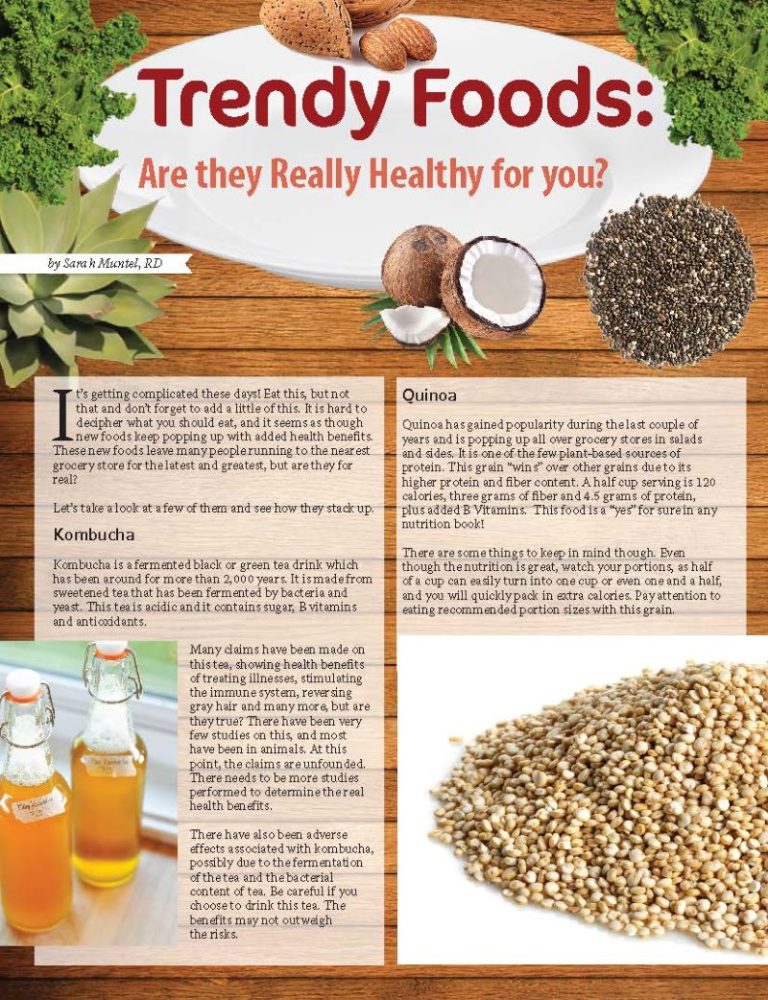Trendy Foods: Are they Really Healthy for you?


by Sarah Muntel, RD
Summer 2016
It’s getting complicated these days! Eat this, but not that and don’t forget to add a little of this. It is hard to decipher what you should eat, and it seems as though new foods keep popping up with added health benefits. These new foods leave many people running to the nearest grocery store for the latest and greatest, but are they for real? Let’s take a look at a few of them and see how they stack up.
Kombucha
Kombucha is a fermented black or green tea drink which has been around for more than 2,000 years. It is made from sweetened tea that has been fermented by bacteria and yeast. This tea is acidic and it contains sugar, B vitamins and antioxidants.
Many claims have been made on this tea, showing health benefits of treating illnesses, stimulating the immune system, reversing gray hair and many more, but are they true? There have been very few studies on this, and most have been in animals. At this point, the claims are unfounded. There needs to be more studies performed to determine the real health benefits.
There have also been adverse effects associated with kombucha, possibly due to the fermentation of the tea and the bacterial content of tea. Be careful if you choose to drink this tea. The benefits may not outweigh the risks.
Quinoa
Quinoa has gained popularity during the last couple of years and is popping up all over grocery stores in salads and sides. It is one of the few plant-based sources of protein. This grain “wins” over other grains due to its higher protein and fiber content. A half cup serving is 120 calories, three grams of fiber and 4.5 grams of protein, plus added B Vitamins. This food is a “yes” for sure in any nutrition book!
There are some things to keep in mind though. Even though the nutrition is great, watch your portions, as half of a cup can easily turn into one cup or even one and a half, and you will quickly pack in extra calories. Pay attention to eating recommended portion sizes with this grain.
Chia Seeds
What is it with these small brown, gray, black and white seeds? They seem to be everywhere these days! These small seeds absorb up to 12 times their weight in liquid when soaked, and then form a gel texture. They can be used in many ways, but they are commonly used in smoothies, bars and yogurts.
Nutritionally, these small seeds pack a big punch! They are rich in B Vitamins, calcium, iron, magnesium and phosphorus. They are also a great source of fiber, protein and omega 3’s. In a one ounce serving, you will get 11 grams of fiber and four grams of protein. Although some initial studies have not shown the benefits of chia seeds, the nutritional breakdown alone makes them a winner in our book!
Kale
Kale chips, kale salad, kale everything! This leafy, green super food from the cabbage family packs quite a nutritional punch. It is high in vitamin A, vitamin C, vitamin K, and B6, just to name a few. It is also high in phytonutrients, such as carotenoids, lutein and zeaxanthin. Kale can add flavor, color and variety to many dishes. It’s a nutrition YES!
Greek Yogurt
High protein items seem to be the rage these days, which has turned people to Greek yogurt. When you compare plain Greek yogurt to regular yogurt, you find a higher protein content, typically less sugar, a thicker consistency and the same live bacterial cultures.
Some people find that Greek yogurt needs some flavoring. Add some fresh fruit for sweetness, or mix in whole grain oats. There are great low-fat and low-sugar flavored varieties in stores everywhere. These products add some sweetness without the extra calories. This is a nutrition win for sure.
Be careful, though — not all Greek yogurt products are the same. Since this is a new buzz word, you see it all over the grocery store. Greek yogurt covered pretzels, Greek yogurt cakes and Greek yogurt cereal bars are some examples. Many of these products have lots of added sugar. Just because it says Greek, it doesn’t automatically make it a good product. Take a good look at the label before you add these to your shopping cart!
Flaxseed
Flaxseed from the flax plant has been used for years, starting with Egyptians. Flaxseed contains protein and fiber, which can help with satiety as part of a balanced diet. Additionally, flaxseed is rich in alpha-linolenic acid (ALA), an omega 3 fatty acid that has been shown to reduce the risk of heart disease and arthritis. Flaxseed also contains lignans, a phytoestrogen, and there are mixed studies on the benefit of lignans in fighting cancer.
Flaxseed can be added to many varieties of foods. There are many health claims surrounding flaxseed, and most of these claims are due to the composition of flaxseed and its great nutritional breakdown. More research is being done, but flaxseed is something that can be of great benefit to a balanced diet. Give it a try!
Agave Nectar
The “oh so natural” agave nectar is processed from plants. You see it around, frequently sweetening foods, and it’s natural, right? Is this the perfect sweetener for you? Well… no. Agave nectar may be natural, but it isn’t any better than plain old sugar, and could possibly even be worse for you.
Calorically, agave has 60 calories per tablespoon, verses 40 calories per tablespoon of sugar. It is sweeter than sugar, so you may use a little less, but you certainly don’t save any calories with this. Additionally, agave nectar is mostly made up of fructose. Fructose consumption can lead to insulin resistance and increased triglyceride levels, both of which can increase your risk of developing heart disease.
In the long run, agave nectar is one to limit. Instead, try Stevia – a natural, less calorically-dense product.
Coconut Products
Coconut flour, coconut oil, and coconut water (just to name a few) are some of the new products you’ll see while browsing the grocery aisle. People use coconut oil for moisturizing and other beauty rituals, so it can also be found in the beauty aisle.
Coconut oil: Coconut oil is extracted from the fruit of mature coconuts. It is a saturated fat, which consumers have been historically advised to stay away from. It is composed of lauric acid, which is a medium chain fatty acid, and has been shown to benefit your cholesterol levels by increasing your HDL’s (good cholesterol). This may make it a better choice than other saturated fats that may also contain trans-fat, but it can still have a negative impact on your LDL’s (good cholesterol).
The bottom line: This can be a substitute for other fats, but it is still a high caloric food so it’s not a free-for-all. Consider substituting it for other oils in moderation, but never add it to your diet or your calories will increase, and so will your waist!
Coconut flour: Coconut flour can be a nice substitute for regular flour, although it’s a little thicker and denser. You may have to modify your recipes a bit, and it is a gluten free option. Per 1/4 cup serving, it has 10 grams of fiber (versus the 0.8 grams found in white flour), and 16 grams of carbohydrate (versus the 24 grams found in white flour). This is a nutrition win. Give it a try!
Almond Milk
Almond milk is exactly what it sounds like — a plant milk with a nutty taste. Almond milk is made with almonds and water. A plus to almond milk is that it does not contain lactose, and that makes it a great vegan option. It gained increased popularity during the last several years.
The upside? Almond milk contains 40 calories per cup (versus the 90 calories found in skim milk), so it can be a calorie-saver. It is also lower in carbohydrates, which can be a plus for diabetics, and is fortified with calcium, so it is very similar to the calcium content of milk. Almond milk is low in fat and naturally cholesterol free, which is a bonus. The downside? Protein. Almond milk is lower in protein than cow’s milk. For those who are counting protein grams, this product is lacking.
The verdict? Sure! This can be a great option for many people. Just beware of the lower protein count. If you feel you are looking for a higher protein choice, opt for cow’s milk.
Pulses
A pulse is a mix of dried beans, peas and lentils that has been used all over the world. You can find it in soups and chili. A one-half cup cooked serving is equivalent to one vegetable serving and a two ounce meat equivalent. It is full of protein and fiber and contains a whole mix of vitamins including iron, zinc, folate and magnesium, as well as several antioxidants. These mixes can improve lipid profiles and are a low glycemic index food. Other claims include decreasing risk of chronic disease, but more research needs to be completed.
This one is easy- a nutrition yes!
Protein Bars
Protein bars are a quick meal or snack option for many in our busy days and crazy schedules. When people don’t have time to prepare a meal or snack, they can quickly grab a protein bar. These bars are wrapped up in a package and look like the picture of health. This sounds like a great idea in theory, but what is the nutritional breakdown of these bars we grab?
Before you grab a bar, take a look at the label. Many bars have added sugar, are higher in carbohydrates and have less protein than you would think. Some bars are really not any better nutritionally than a candy bar. Here’s a tip, make sure the bar has at least 15-20 grams of protein and make sure the sugar content is lower (around five grams). The majority of these won’t meet those nutritional guidelines, so look closely.
Conclusion:
There are so many products available these days. It takes a savvy shopper, label reader, and nutrition guru to determine what works. We can’t possibly cover all of them in one article, but here are a few tips to think about:
- Look at the label: The less ingredients on the list, the better. Look for ingredients you are aware of or at least can pronounce.
- Don’t believe everything you see online: There is a lot of good information on the Internet, and there is a lot of not-so-good information. Go to a trusted site for your information. When in doubt, ask. Find a registered dietitian or health professional to answer your question.
- Back to basics: You really can’t go wrong with fruits, vegetables, dairy and protein. Sometimes that’s all you need. There really is no such thing as a magic food.
At the end of the day, do the best you can. No one is perfect. Small steps and changes can make a huge impact in your overall health!
About the Author:
Sarah Muntel, RD, is a Registered Dietitian and Bariatric Coordinator at Community Bariatric Surgeons in Indianapolis, IN. She has worked with bariatric surgery patients for 17 years and especially enjoys leading support groups. In her free time, she enjoys spending time with her husband and three children.
With the holidays behind us and 2022 now here, many of us are ready to tackle our…
View Videoby Kristen Smith, MS, RDN Winter 2022 When you decide to change your dietary habits, it can…
Read Articleby Amy Thul, RD, LD, CSOWM Winter 2022 It’s dinner time and you’re running around the kitchen,…
Read Article










